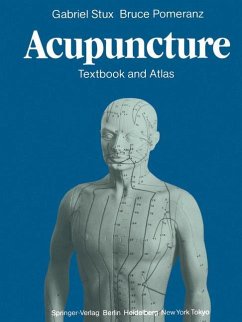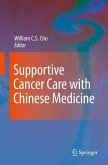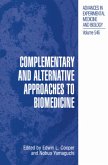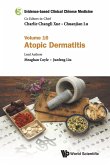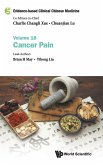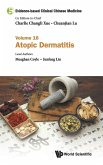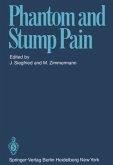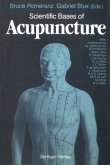Gabriel Stux, Bruce PomeranzTextbook and Atlas
Acupuncture
Textbook and Atlas
Übersetzung: Sahm, Karl A.; Illustration: Kofen, Petra
Gabriel Stux, Bruce PomeranzTextbook and Atlas
Acupuncture
Textbook and Atlas
Übersetzung: Sahm, Karl A.; Illustration: Kofen, Petra
- Broschiertes Buch
- Merkliste
- Auf die Merkliste
- Bewerten Bewerten
- Teilen
- Produkt teilen
- Produkterinnerung
- Produkterinnerung
Following an introduction to the philosophical and theoreti- cal background of traditional Chinese medicine, the dia- gnostic system is presented: the Chinese system of channels and functional organs, the significance of pointsand point categories, methods of needling and moxibustion. There is a chapter on treatment based on western diagnosis.
Andere Kunden interessierten sich auch für
![Supportive Cancer Care with Chinese Medicine Supportive Cancer Care with Chinese Medicine]() Supportive Cancer Care with Chinese Medicine112,99 €
Supportive Cancer Care with Chinese Medicine112,99 €![Complementary and Alternative Approaches to Biomedicine Complementary and Alternative Approaches to Biomedicine]() Complementary and Alternative Approaches to Biomedicine62,99 €
Complementary and Alternative Approaches to Biomedicine62,99 €![EVIDENCE-BASE CLIN CHN MED (V16) EVIDENCE-BASE CLIN CHN MED (V16)]() Meaghan Coyle & Junfeng LiuEVIDENCE-BASE CLIN CHN MED (V16)58,99 €
Meaghan Coyle & Junfeng LiuEVIDENCE-BASE CLIN CHN MED (V16)58,99 €![EVIDENCE-BASE CLIN CHN MED (V18) EVIDENCE-BASE CLIN CHN MED (V18)]() Brian H May & Yihong LiuEVIDENCE-BASE CLIN CHN MED (V18)141,99 €
Brian H May & Yihong LiuEVIDENCE-BASE CLIN CHN MED (V18)141,99 €![EVIDENCE-BASE CLIN CHN MED (V16) EVIDENCE-BASE CLIN CHN MED (V16)]() Meaghan Coyle & Junfeng LiuEVIDENCE-BASE CLIN CHN MED (V16)118,99 €
Meaghan Coyle & Junfeng LiuEVIDENCE-BASE CLIN CHN MED (V16)118,99 €![Phantom and Stump Pain Phantom and Stump Pain]() Phantom and Stump Pain77,99 €
Phantom and Stump Pain77,99 €![Scientific Bases of Acupuncture Scientific Bases of Acupuncture]() Scientific Bases of Acupuncture92,99 €
Scientific Bases of Acupuncture92,99 €-
-
-
Following an introduction to the philosophical and theoreti-
cal background of traditional Chinese medicine, the dia-
gnostic system is presented: the Chinese system of channels
and functional organs, the significance of pointsand point
categories, methods of needling and moxibustion. There is a
chapter on treatment based on western diagnosis.
Hinweis: Dieser Artikel kann nur an eine deutsche Lieferadresse ausgeliefert werden.
cal background of traditional Chinese medicine, the dia-
gnostic system is presented: the Chinese system of channels
and functional organs, the significance of pointsand point
categories, methods of needling and moxibustion. There is a
chapter on treatment based on western diagnosis.
Hinweis: Dieser Artikel kann nur an eine deutsche Lieferadresse ausgeliefert werden.
Produktdetails
- Produktdetails
- Verlag: Springer / Springer Berlin Heidelberg / Springer, Berlin
- Artikelnr. des Verlages: 978-3-642-71744-4
- Softcover reprint of the original 1st ed. 1987
- Seitenzahl: 360
- Erscheinungstermin: 18. November 2011
- Englisch
- Abmessung: 280mm x 210mm x 20mm
- Gewicht: 902g
- ISBN-13: 9783642717444
- ISBN-10: 3642717446
- Artikelnr.: 36114980
- Herstellerkennzeichnung
- Springer-Verlag GmbH
- Tiergartenstr. 17
- 69121 Heidelberg
- ProductSafety@springernature.com
- Verlag: Springer / Springer Berlin Heidelberg / Springer, Berlin
- Artikelnr. des Verlages: 978-3-642-71744-4
- Softcover reprint of the original 1st ed. 1987
- Seitenzahl: 360
- Erscheinungstermin: 18. November 2011
- Englisch
- Abmessung: 280mm x 210mm x 20mm
- Gewicht: 902g
- ISBN-13: 9783642717444
- ISBN-10: 3642717446
- Artikelnr.: 36114980
- Herstellerkennzeichnung
- Springer-Verlag GmbH
- Tiergartenstr. 17
- 69121 Heidelberg
- ProductSafety@springernature.com
1 Scientific Basis of Acupuncture.- 1.1 Acupuncture Analgesia (Basis Research).- 1.2 Acupuncture Analgesia for Chronic Pain.- 1.3 Drug Addiction.- 1.4 Asthma, Nerve Regeneration and Cardiovascular Effects of Acupuncture.- 1.5 Acupuncture Points (Do They Really Exist?).- 2 History of Acupuncture.- 3 Background and Theory of Traditional Chinese Medicine.- 3.1 Tao, Yin and Yang.- 3.2 The Cosmic Vital Energy: Qi.- 3.3 Jing, the Life Essence.- 3.4 Shen, or Psychic Energy.- 3.5 Disturbances of Qi.- 3.6 The System of Five Phases.- 3.7 External Climatic Factors.- 3.8 Internal Emotional Factors.- 4 Diagnosis in Traditional Chinese Medicine.- 4.1 Eight Diagnostic Criteria, Ba gang.- 4.2 Interior and Exterior Li, Biao.- 4.3 Excess and Deficiency Shi, Xu.- 4.4 Heat and Cold Re, Han.- 4.5 Yin and Yang.- 4.6 Four Examinations Si zh?n.- 4.7 Visual Observation Wàng zh?n.- 4.8 Listening and Smelling Wén zh?n.- 4.9 Questioning Wèn zh?n.- 4.10 Physical Examination Qie zh?n.- 5 Chinese System of Channels,Organs and Points.- 5.1 Channels and Organs.- 5.2 Presentation of the Point Categories.- 5.3. Methods of Point Location.- 6 Systematic Description of Channels and Points.- 6.1 Lung Channel.- 6.2 Large Intestine Channel.- 6.3 Stomach Channel.- 6.4 Spleen Channel.- 6.5 HeartChannel.- 6.6 Small Intestine Channel.- 6.7 Urinary Bladder Channel.- 6.8 Kidney Channel.- 6.9 Pericardium Channel.- 6.10 Sanjiao Channel.- 6.11 Gallbladder Channel.- 6.12 LiverChannel.- 6.13 Du Mai.- 6.14 Ren Mai.- 6.15 Chong Mai.- 6.16 Dai Mai.- 6.17 Yangqiao.- 6.18 Yinqiao.- 6.19 Yangwei.- 6.20 Yinwei.- 6.21 Extra Points.- 7 Regions with Important Acupuncture Points.- 7.1 Face.- 7.2 NeckArea.- 7.3 Dorsal Side of the Trunk.- 7.4 Abdominal Area.- 7.5 Shoulder Area.- 7.6 Points Around the Knee Joint.- 8 Technique of Acupuncture.- 8.1 Acupuncture Needles.- 8.2 Technique of Insertion and Stimulation of the Needles.- 8.3 De Qi Sensation.- 8.4 Tonifying and Sedating Methods of Stimulation.- 8.5 Electroacupuncture, Electrostimulation.- 8.6 Sterilization of the Needles.- 8.7 Complications of Acupuncture Treatment.- 9 Moxibustion.- 9.1 Indications and Methods.- 9.2 Direct Moxibustion.- 9.3 Indirect Moxibustion with Ginger Slice Isolation.- 9.4 Moxibustion with "Moxa Cigars".- 9.5 Moxibustion by Heating Acupuncture Needles.- 9.6 Infrared Moxibustion.- 10 Laser Acupuncture.- 11 Acupressure.- 12 Ear Acupuncture.- 12.1 Technique of Ear Acupuncture.- 12.2. Representation of the Body on the Auricle.- 12.3 Numbering of Ear Points.- 12.4 Rules for Selection of Ear Points.- 13 Scalp Acupuncture.- 13.1 Fourteen Lines for Treatment.- 13.2 Method of Needling.- 14 Hand Acupuncture.- 14.1 Points of the Dorsum of the Hand.- 14.2 Points on the Palm.- 15 Acupuncture Treatment.- 15.1 Principles of Acupuncture and Major Rules of Point Selection.- 15.2 Locomotor Disorders.- 15.3 Respiratory Disorders.- 15.4 Cardiovascular Disorders.- 15.5 Gastroenterological Disorders.- 15.6 Mental Disturbances and Illnesses.- 15.7 Neurologic Disorders.- 15.8 Gynecological Disorders.- 15.9 Urological Disorders.- 15.10 SkinDisorders.- 15.11 Disorders of the Sense Organs.- 15.12 Acute Disorders and Emergencies.- Appendixes A-H.- A. World Health Organization List of Indications for Acupuncture.- B. Nomenclature and Abbreviations for Channels and Points.- C. Glossary of Chinese Terms.- D. Translation of Chinese Ideograms and Point Names.- E. Alphabetic List of Chinese Point Names.- F. Index of Indications for Acupuncture.- H. System of the Five Phases.- Literature.
1 Scientific Basis of Acupuncture.- 1.1 Acupuncture Analgesia (Basis Research).- 1.2 Acupuncture Analgesia for Chronic Pain.- 1.3 Drug Addiction.- 1.4 Asthma, Nerve Regeneration and Cardiovascular Effects of Acupuncture.- 1.5 Acupuncture Points (Do They Really Exist?).- 2 History of Acupuncture.- 3 Background and Theory of Traditional Chinese Medicine.- 3.1 Tao, Yin and Yang.- 3.2 The Cosmic Vital Energy: Qi.- 3.3 Jing, the Life Essence.- 3.4 Shen, or Psychic Energy.- 3.5 Disturbances of Qi.- 3.6 The System of Five Phases.- 3.7 External Climatic Factors.- 3.8 Internal Emotional Factors.- 4 Diagnosis in Traditional Chinese Medicine.- 4.1 Eight Diagnostic Criteria, Ba gang.- 4.2 Interior and Exterior Li, Biao.- 4.3 Excess and Deficiency Shi, Xu.- 4.4 Heat and Cold Re, Han.- 4.5 Yin and Yang.- 4.6 Four Examinations Si zh?n.- 4.7 Visual Observation Wàng zh?n.- 4.8 Listening and Smelling Wén zh?n.- 4.9 Questioning Wèn zh?n.- 4.10 Physical Examination Qie zh?n.- 5 Chinese System of Channels,Organs and Points.- 5.1 Channels and Organs.- 5.2 Presentation of the Point Categories.- 5.3. Methods of Point Location.- 6 Systematic Description of Channels and Points.- 6.1 Lung Channel.- 6.2 Large Intestine Channel.- 6.3 Stomach Channel.- 6.4 Spleen Channel.- 6.5 HeartChannel.- 6.6 Small Intestine Channel.- 6.7 Urinary Bladder Channel.- 6.8 Kidney Channel.- 6.9 Pericardium Channel.- 6.10 Sanjiao Channel.- 6.11 Gallbladder Channel.- 6.12 LiverChannel.- 6.13 Du Mai.- 6.14 Ren Mai.- 6.15 Chong Mai.- 6.16 Dai Mai.- 6.17 Yangqiao.- 6.18 Yinqiao.- 6.19 Yangwei.- 6.20 Yinwei.- 6.21 Extra Points.- 7 Regions with Important Acupuncture Points.- 7.1 Face.- 7.2 NeckArea.- 7.3 Dorsal Side of the Trunk.- 7.4 Abdominal Area.- 7.5 Shoulder Area.- 7.6 Points Around the Knee Joint.- 8 Technique of Acupuncture.- 8.1 Acupuncture Needles.- 8.2 Technique of Insertion and Stimulation of the Needles.- 8.3 De Qi Sensation.- 8.4 Tonifying and Sedating Methods of Stimulation.- 8.5 Electroacupuncture, Electrostimulation.- 8.6 Sterilization of the Needles.- 8.7 Complications of Acupuncture Treatment.- 9 Moxibustion.- 9.1 Indications and Methods.- 9.2 Direct Moxibustion.- 9.3 Indirect Moxibustion with Ginger Slice Isolation.- 9.4 Moxibustion with "Moxa Cigars".- 9.5 Moxibustion by Heating Acupuncture Needles.- 9.6 Infrared Moxibustion.- 10 Laser Acupuncture.- 11 Acupressure.- 12 Ear Acupuncture.- 12.1 Technique of Ear Acupuncture.- 12.2. Representation of the Body on the Auricle.- 12.3 Numbering of Ear Points.- 12.4 Rules for Selection of Ear Points.- 13 Scalp Acupuncture.- 13.1 Fourteen Lines for Treatment.- 13.2 Method of Needling.- 14 Hand Acupuncture.- 14.1 Points of the Dorsum of the Hand.- 14.2 Points on the Palm.- 15 Acupuncture Treatment.- 15.1 Principles of Acupuncture and Major Rules of Point Selection.- 15.2 Locomotor Disorders.- 15.3 Respiratory Disorders.- 15.4 Cardiovascular Disorders.- 15.5 Gastroenterological Disorders.- 15.6 Mental Disturbances and Illnesses.- 15.7 Neurologic Disorders.- 15.8 Gynecological Disorders.- 15.9 Urological Disorders.- 15.10 SkinDisorders.- 15.11 Disorders of the Sense Organs.- 15.12 Acute Disorders and Emergencies.- Appendixes A-H.- A. World Health Organization List of Indications for Acupuncture.- B. Nomenclature and Abbreviations for Channels and Points.- C. Glossary of Chinese Terms.- D. Translation of Chinese Ideograms and Point Names.- E. Alphabetic List of Chinese Point Names.- F. Index of Indications for Acupuncture.- H. System of the Five Phases.- Literature.

